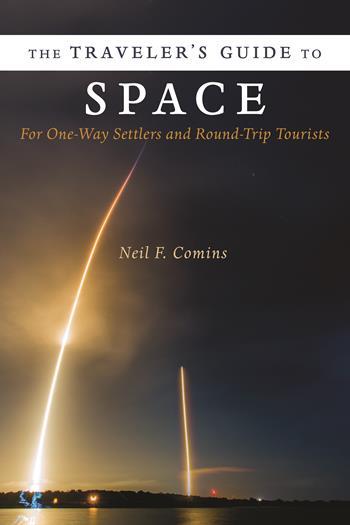The Traveler’s Guide to Space
“Once you get through the initial adjustment period, the fun begins, but with the caveat that just not everything you enjoy on Earth will be fun out there and things that you wouldn’t think if doing here, such as talking to someone who is upside down in front of you, or eating food that is floating, rather than on a plate, will be interesting experiences.” — Neil Comins
This week, our featured book is The Traveler’s Guide to Space: For One-Way Settlers and Round-Trip Tourists, by Neil F. Comins. Today, we are happy to present a guest post by Comins introducing some of the ideas in his book.
Don’t forget to enter our book giveaway for a chance to win a free copy of The Traveler’s Guide to Space!
The Traveler’s Guide to Space
By Neil F. Comins
The era of civilian and commercial space travel has arrived, with paying tourists visiting the International Space Station and private companies developing rockets and other hardware to be used in space. Building on the knowledge about living in space gained over the past 65 years, countries and companies are making real plans to visit and perhaps colonize our Moon, as well as visiting other bodies in space, such as nearby asteroids and passing comets.
As exciting and romantic as such adventures are, none of them are as simple, straight-forward, or accessible as, for example, journeys to countries half way around the world. The latter trips basically require: arranging accommodations and activities; booking flights; getting a passport and visa (if necessary); getting any necessary inoculations and a supply of the medicines you need, along with medical insurance if necessary; letting your credit card company know you are making the trip, and, packing. Each of these things can be accomplished in a matter of minutes to hours, with the whole process taking perhaps a week, and much less time for the seasoned traveler. Preparing for a trip into space, whether just a quick ride above the boundary that defines space and back, a trip into orbit, one in which you leave Earth’s thrall, will require months, or even years of preparation, depending on the voyage. Astronauts preparing to go to the International Space Station today train for more than two years.
Virtually every aspect of life changes when you go into space. Adjusting to living out there, whether for a few days or a lifetime, is uncomfortable as your body gets acclimated to the lack of gravity, called microgravity. Besides the space sickness and physical changes in your body that microgravity causes, you will find that eating, another one of the pleasures on Earth, is a notably different experience in space, too. Food tastes much blander out there and so food that is crafted to be consumed in space is often accompanied by stronger spices than you would consider using on Earth.
Once you get through the initial adjustment period, the fun begins, but with the caveat that just not everything you enjoy on Earth will be fun out there and things that you wouldn’t think if doing here, such as talking to someone who is upside down in front of you, or eating food that is floating, rather than on a plate, will be interesting experiences. If you ever dreamed of flying like superwoman or superman, you will have the opportunity to do that in space, or at least to float weightlessly from one side of a room to another. You will also be able to heft and even throw people who, on Earth, would weigh much more than you do.
Next time you have sex, I invite you to think about the role gravity plays in your interactions with your companion. Microgravity changes many aspects of sexual relations, so substitute technology will have to be developed in order for you to be able to do it, much less enjoy it, up there.
Obviously, space journeys to different destinations will take different lengths of time and each will present you with different experiences and opportunities at your goal. Space travel will require, among other things, significant training on getting along with people from different cultures, countries, races, religions, and philosophies. You will also have to learn to make good use of your time on extended journeys, to prevent boredom, which can actually become dangerous.
Because every world that will be available to visit this century is different in size, composition, shape, and surface features, what you can see and do will depend intimately on your destination. Without a doubt, the most exotic, glamorous, and diverse world that may be on that list is Mars. However, the challenges involved in providing a viable habitat there, as well as reliable landers and, for those making round trip journeys, vehicles to return to orbit are substantial.
In The Traveler’s Guide to Space: For Round-Trip Tourists and One-Way Settlers, I explore all these aspects of space travel in the near future and much more. I also discuss activities and experiences available on different worlds in our astronomical neighborhood. The book is written both for people interested in going into space and anyone else who would like to see the big picture of space travel.



